Day 2 of a three day long weekend of Summer Tours today. It was another sunny day – lovely weather to be out and about, even if the temperature does mean that a lot of the smaller birds go quiet in the heat of the day.
Our first destination was Holkham. As we got out of the car at the north end of Lady Anne’s Drive, we could hear Grey Partridge calling from the grazing meadow. It was just visible for a couple of seconds before it walked back into the taller grass and disappeared.
There were not many birds singing now as we set off west along the track on the edge of the pines. We did hear a Blackcap deep in the trees and a Wren on this first stretch of the path. It wasn’t long before we encountered a tit flock – suddenly we didn’t know where to look, with Long-tailed Tits, Blue Tits and Coal Tits feeding in the trees either side of us. A Treecreeper appeared in a pine tree close by, allowing us to get a good look at it as it climbed up the trunk. Three Goldcrests were calling and flicking their wings in a small group high above the track.
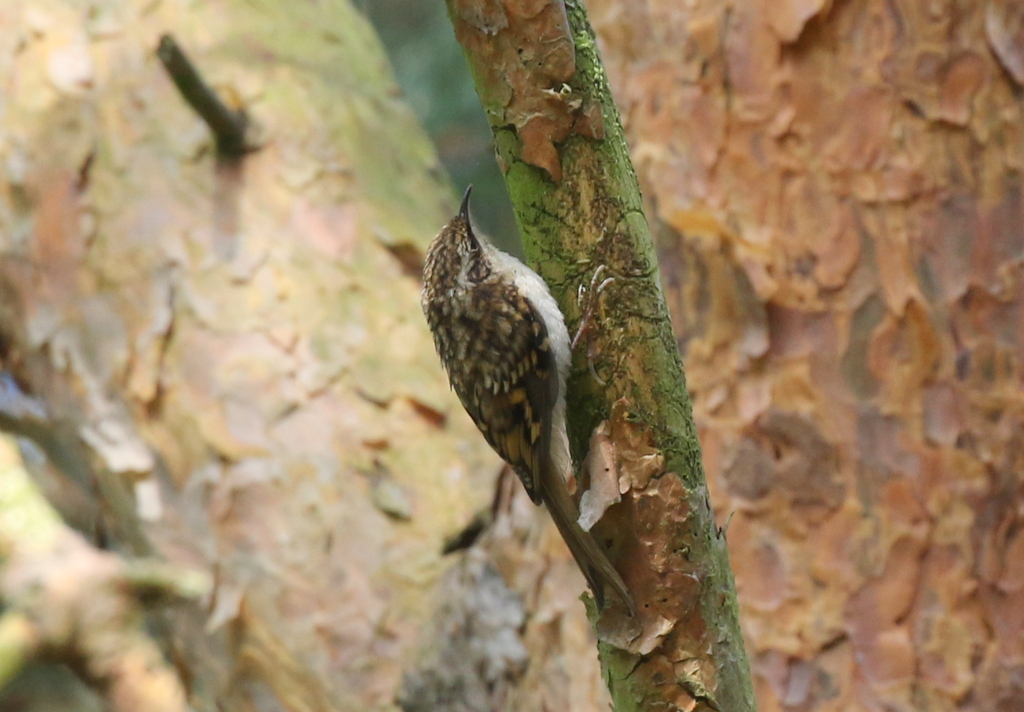
Salts Hole just held a few Mallard and a Moorhen, so we continued on. We saw quite a few butterflies in the brambles and bushes by the path Gatekeeper, Meadow Brown and Ringlet, both Large and Green-veined White, Red Admiral and Peacock. When we got to the elms just before Washington Hide, we stopped and scanned the tops of the trees. It didn’t take long to find a small butterfly fluttering around the branches, a White-letter Hairstreak. It eventually landed in view and we could see the distinctive white line on the underside of its wings.
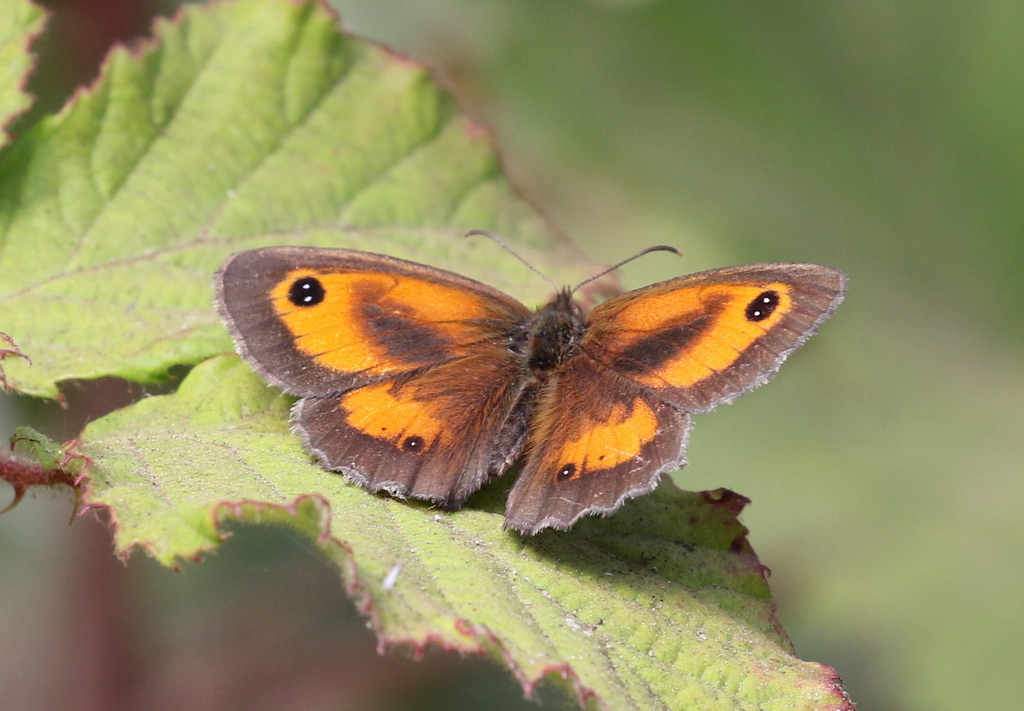
There is a better view from higher up on the boardwalk, so we stopped just outside Washington Hide to scan the grazing marshes. There were a couple of juvenile Marsh Harriers practicing their flying skills out over the reeds. We saw our first Spoonbills of the day too, two of them circling out over the middle of the marshes, and there were a couple of others perched in the trees in the distance. A Great White Egret flew up out of the reeds by the pool in front of the hide, but dropped down behind the sallows before everyone could get a look at it.
As we approached Meals House, a male Bullfinch flew off from the reeds by the garden and landed in a sallow at the back. It perched in full view, so we got a good look at it, bright pink underneath with a black cap. It flew across and landed down on the edge of the garden and we could see it feeding on the brambles by the fence when we looked from the gate. A female Bullfinch was feeding with it here too.
Before we even got to Joe Jordan Hide, we could see all the Spoonbills on the edge of the pool out in front. From up in the hide, we could count them. There were at least 15 juveniles, ‘teaspoonbills’ with partly grown bills, and 3-4 adults with them, although there was steady coming and going. Several of the juvenile Spoonbills were begging for food from their parents – bobbing their heads up and down and flapping their wings. We watched them pursue the adults relentlessly around the pool!
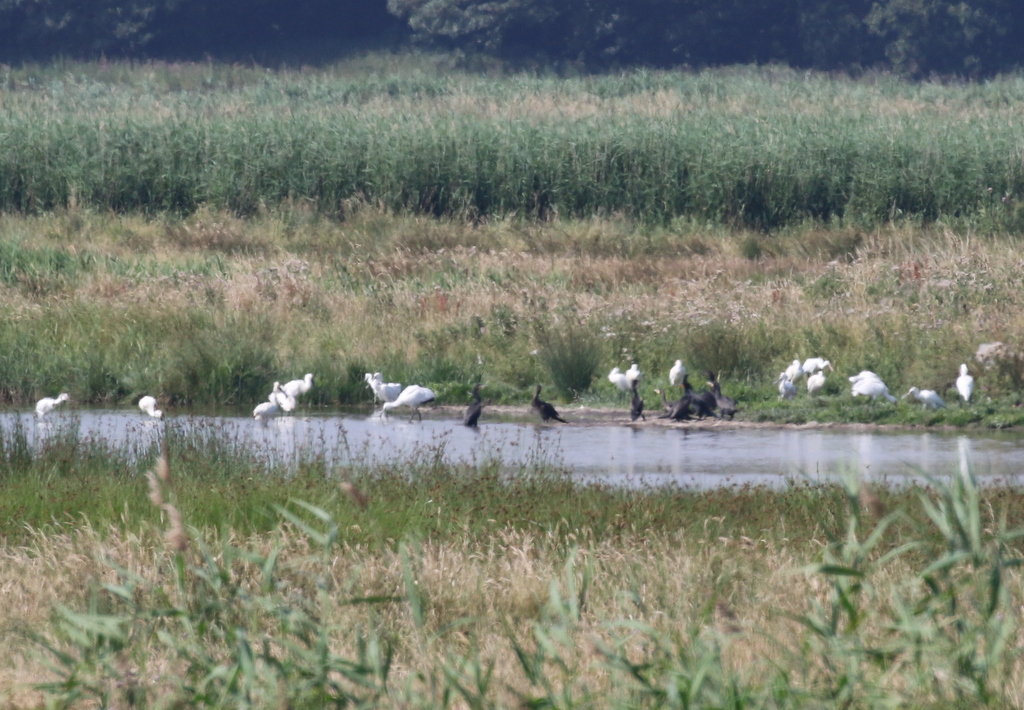
A Great White Egret appeared, flying in over the grazing marsh, but quickly dropped down into a ditch out of view. A little while later, another Great White Egret flew out of the trees and across the grass of the fort, before dropping down into the same place.
There were more juvenile Marsh Harriers in front of the hide here too, practicing their flying. Three Common Buzzards circled up over the grass and a Kestrel perched in a hawthorn out on the edge of one of the ditches.
Leaving the hide, we walked through the pines and out into the dunes. The orchids here are now largely over, but there were one or two Marsh Helleborines still flowering. We were hoping to catch up with some butterflies here, but it was rather quiet at first. A Common Blue fluttered past and then a Brown Argus appeared. We found a couple of Six-spot Burnet moths feeding on the thistles. Eventually one Dark Green Fritillary put in an appearance, but it was just a quick fly past – blink, and you missed it!

Scanning the beach from the top of the dunes, it all looked very quiet, bird-wise at least. Two Gannets flew east offshore, way off in the distance. On the way back through the dunes, there were a few more Dark Green Fritillaries, but they were very mobile in the heat. One did drop down into the grass briefly but it was quickly on its way again.
The trees were even quieter now, in the heat of the middle of the day. We did find a Drinker moth on the path on our way back. A Jay was feeding in the shade underneath the trees by the path.

It was time for lunch when we arrived at Titchwell, where we planned to spend the afternoon. We made good use of the tables in the picnic area. A Southern Hawker was feeding around the sallows just across the path while we ate.
After lunch, we made our way out onto the reserve. There is nothing on the dried-up grazing meadow ‘pool’ now, but there were lots of ducks on the reedbed pool. Most of the drakes are in their drab eclipse plumage now, but in with the Mallard, Gadwall and Common Pochard, we did find two female Red-crested Pochards. Two Little Grebes were diving along the edge of the reeds towards the back.
We heard Bearded Tits pinging in the reeds by the path and saw one or two zooming across the tops before diving in. One perched up briefly. There were several Reed Warblers too. The juvenile Marsh Harriers were flying round over the reeds here too and were joined at one point by a smart grey-winged male.
Just before Island Hide, we stopped to scan the Freshmarsh. There were more Bearded Tits here, with birds pretty much constantly flying back and forth between the reeds either side of the mud. On the edge of the island at the back, we could see more Spoonbills, at least ten of them at first, with another two then flying in to join them. A single Little Gull, a first summer, was swimming round in circles along the edge of the reeds, picking at the surface.
There are lots of waders on the Freshmarsh at the moment – particularly Avocets and Black-tailed Godwits. In amongst one of the roosting flocks of the latter, we found a summer-plumage Bar-tailed Godwit – even though it was asleep, we could see the rusty colour of its underparts extending right down under the tail. There were a few Knot with them too, all still in orange breeding plumage. Three adult Curlew Sandpipers were feeding together nearby, still sporting their summer rusty underparts, and there were several small groups of Dunlin too.
Some of the Spotted Redshanks have been back a while now and have been moutling fast out of their black breeding plumage. The first one we saw was almost completely in its silvery-grey winter plumage already.
There were some Ruff right in front of Island Hide, so we popped in for a closer look. They are also moulting fast, the males losing their ornate ruff feathers very soon after they get back. With birds in different states of moult, and still sporting some breeding feathers in a variety of colours, the variation in appearance is really amazing!

Having disappeared yesterday, the Lesser Yellowlegs was relocated on the Tidal Pools just as we arrived at Titchwell. Helpfully, by the time we got out to the Freshmarsh, it had flown back on here. We quickly found it, right out in the middle with all the other waders. It stood out, small and slim, with a very fine bill.
It was also interesting to watch the Lesser Yellowlegs feeding, sweeping its bill side to side through the water, rather like a Spotted Redshank. We had a nice comparison at one point while it was feeding next to a couple of Common Redshanks. Four Golden Plover dropped in to one of the islands, to round off the wader collection here nicely.
As well as all the waders, there are still lots of gulls on the Freshmarsh. The Mediterranean Gulls have had a great breeding season and we could see a good number of juveniles still, as well as some very smart adults. There were several Common and Sandwich Terns too, but the only Little Tern was chased off by an Avocet and headed out towards the beach.
While we scanned the Freshmarsh, we kept one eye on the edge of the reeds. We had a couple of brief views of Bearded Tits there before three tawny brown juveniles came out onto the mud opposite the hide. They hopped up and down along the edge, in and out of the reeds, feeding. Now we had some nice scope views of them.
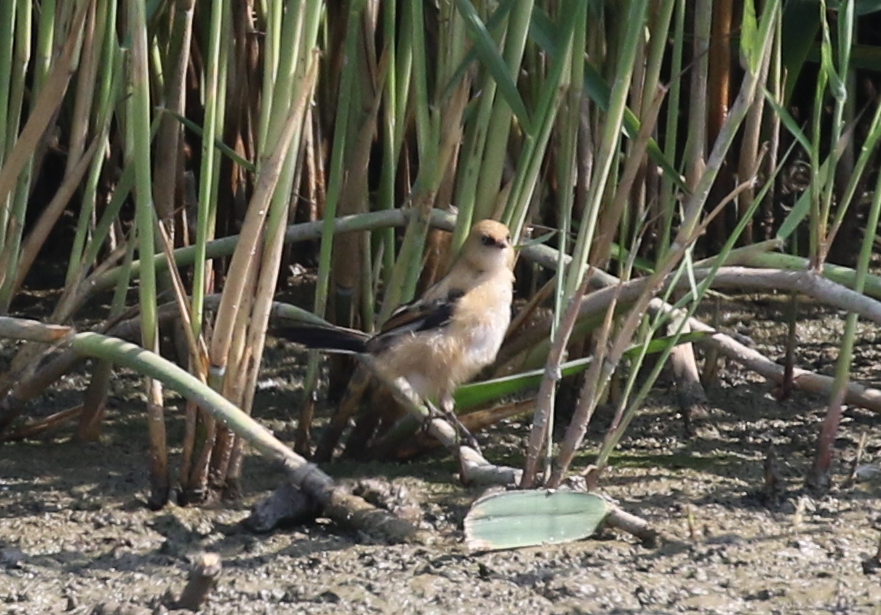
Back up on the main path, we found a juvenile Little Ringed Plover feeding on the mud just below the bank. The two injured Pink-footed Geese appeared from behind the vegetation on one of the islands. They appear unable to fly and have not been able to return to Iceland for the breeding season, but seem to be surviving here.
Carrying on towards the beach, there is not much on Volunteer Marsh at the moment. A Common Redshank walked up out of the channel below the path as we passed and we stopped to admire a couple of Lapwings, their iridescent green upperparts shining bronze and purple in the sunshine. Several Curlews were feeding along the edges of the channel at the far side.
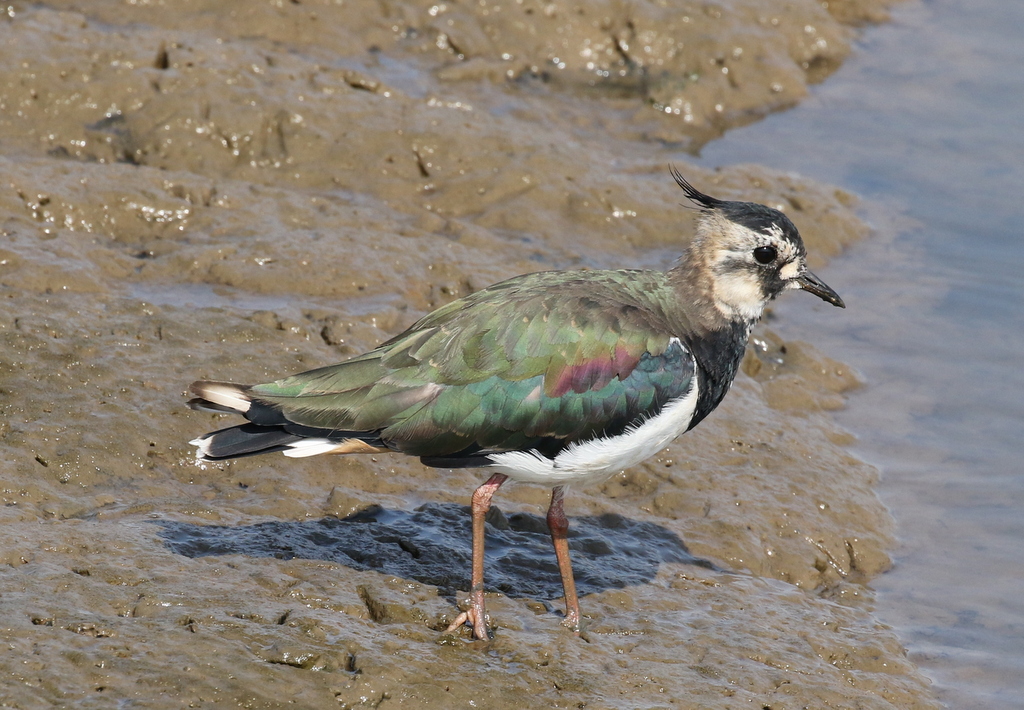
The now non-tidal ‘Tidal Pools’, which have been flooded with seawater since the winter, are steadily starting to dry out a little, exposing some of the muddy islands. There are lots of waders on here at the moment. As well as the usual Oystercatchers, which roost on here over high tide, there were lots of Dunlin and several Turnstones at the back, mostly asleep. The heat haze was a bit of a problem now and we couldn’t find the Temminck’s Stint which had been reported earlier – there are too many places for it to hide here!
Out at the beach, we couldn’t see much out to sea, beyond a few Sandwich Terns passing. The tide was just starting to go out and the mussel beds were still under water, so there were not many waders out here. Two Ringed Plover were feeding on the sand out towards Brancaster. A flock of small waders flew across over the edge of the sea – a group of Sanderling, still in their darker breeding plumage. They doubled back and landed on the edge of the water, where we could get a good look at them in the scope.
On the way back, we stopped to scan the Freshmarsh again. Two Common Snipe had appeared on the mud beside the reeds below the bank out to Parrinder Hide. As we looked beyond them, we saw that the Lesser Yellowlegs had flown in and was now feeding right in front of the hide. We took a quick diversion for a closer look.
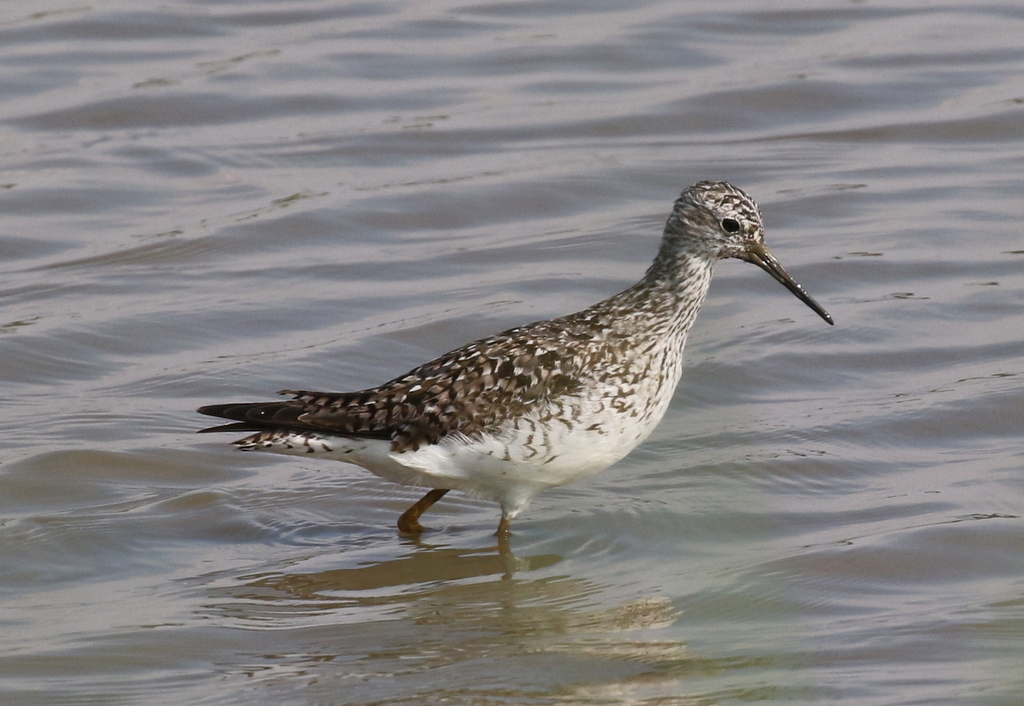
We had a great view of the Lesser Yellowlegs now, feeding right out in front of the hide. Much better than earlier, when it was right out in the middle. It was wading in deeper water now, up to its belly, and probing down into the mud below, rather than sweeping its bill.
It was time to head back, but we had one more diversion on the way. A couple of Bearded Tits were feeding in the reeds around the pools just below the main path and we stopped to watch them. While we were doing so, we heard Whimbrel calling and looked up to see two flying high west overhead, presumably freshly back from the continent.
Then, with a busy evening ahead and needing to get something to eat beforehand, we made our way back to the car.
Nightjar Evening
After a couple of hours rest, we met up again early in the evening. We headed out to look for Little Owls first, up to some barns which are a good place to find them. As we drove up, we noticed a shape on one of the roofs right beside the road and looked up to see a Little Owl staring back at us.
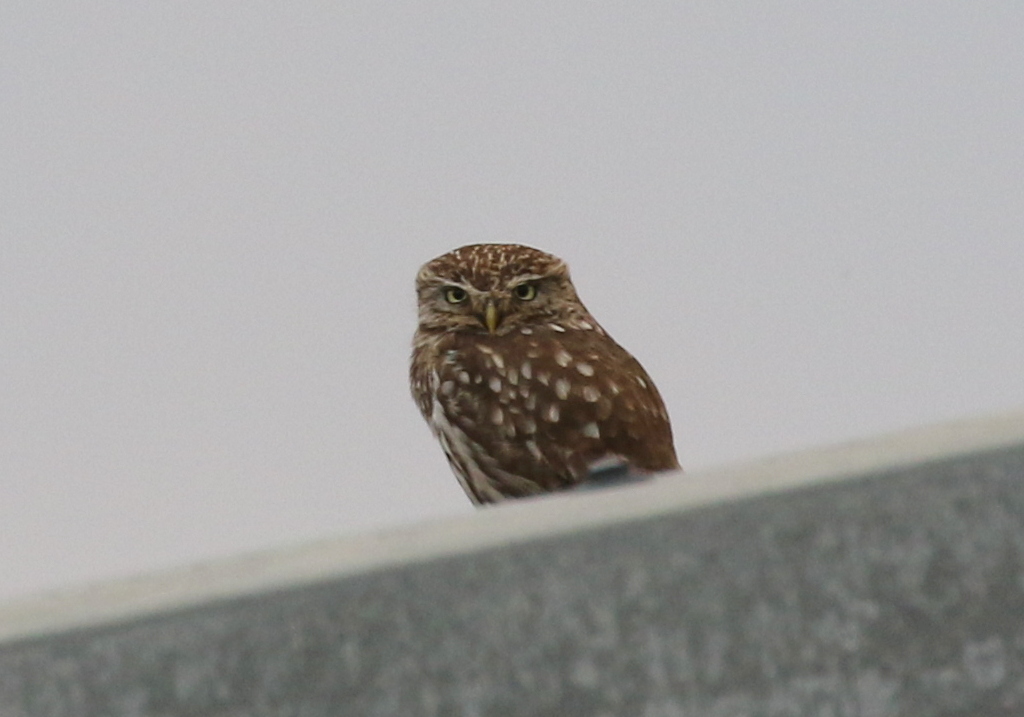
We pulled up in the middle of the road for a look, but just at that moment a car was coming the other way and we had to move. The Little Owl disappeared as the other car passed, so we parked further up along the road and got out. We scanned the roofs of the farm buildings on the other side of the road and found another Little Owl right on the top of a grain silo some distance away. Then a third Little Owl popped up on the top of another silo a little further over. We had a good look at them in the scope.
A couple of Red-legged Partridges were standing on one of the roofs and dropped down to feed on the edge of the concrete below. A smart male Yellowhammer perched high on the top of another, calling. A Brown Hare ran past between the buildings and a large flock of Rooks flew over, heading off to roost. A Hobby flashed past, over the fields and away towards the trees beyond.
Then the first Little Owl reappeared, back on the roof where we had seen it earlier, much closer to us. It had found a spot, tucked down behind the ridge where it could perch and not be easily seen, but we found a good angle and got some nice views through scope.
Having enjoyed such great success with Little Owls, we made our way down towards the coast to look for Barn Owls next. When they have young to feed, the Barn Owls are often out hunting early, but now many of the young have fledged, there are not so many out in the early evening. We drove round and checked out all the various fields where we see them regularly, but no joy.
We had an appointment with some Nightjars, so we couldn’t wait too long for the Barn Owls to appear tonight. We parked and got out, and scanned across a large expanse of marshes. Finally a Barn Owl appeared, albeit rather distantly, and it landed on a post so we could get it in the scope.
It was time to make our way up to the heath now. We parked and walked out to the middle. It was all quiet now, apart from a pair of Stonechats calling out on the gorse.
The first Nightjar started up bang on time. It called from somewhere in the trees first, before churring briefly. Then it flew out of the trees and round in front of us and landed on its favourite perch, right in the scope. We had a great look at it, but unfortunately it only stayed a few seconds before it was off again. It flew round, in and out of the trees, before churring again from somewhere deeper in.
When it came out of the trees again, the Nightjar did another circuit in front of us, then flew straight past us. We had a great view, as it flew past with stiff wing beats, flashing its white wing patches. It flew up into a dense leafy oak behind us, before disappearing off across heath.
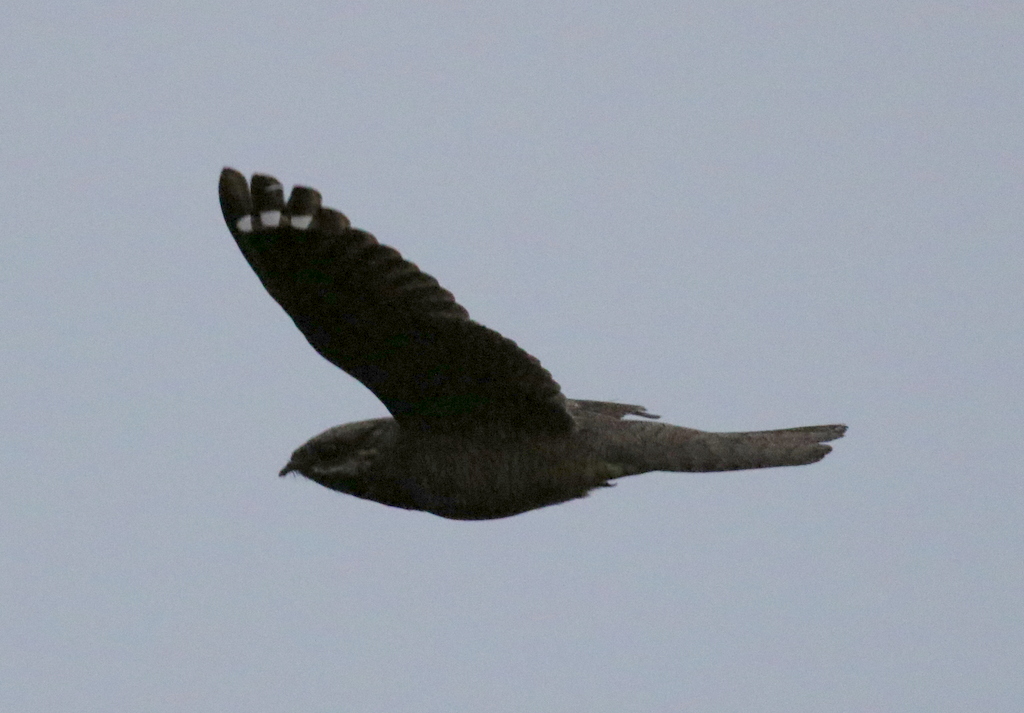
A second Nightjar started up, churring away in the distance, and what was probably the one we had just been watching responded, churring from somewhere out in the middle. They were a bit slow to get going this evening, perhaps given the stage of the breeding season, but as we walked on another two Nightjars started to churr.
We headed over to where we could watch a couple of the favourite perches used by one of the other males, but there was no sign of it coming in tonight. We could still hear the two male Nightjars churring against each other out in the middle. It was great simply to stand for a while and listen to them as the light faded.
It was starting to get dark now, and we were just about to walk back when a Nightjar called along the edge of the trees behind us. It was the male, and it flew in and did a circuit round by the trees, silhouetted against the last of the light. It didn’t land on one of its perches, but flew back out to another favourite oak tree, and started churring again.
As we walked back to the car, we were serenaded by another one or two males churring from the trees across the other side of the heath. We heard one calling, and looked up to see two Nightjars flying round, feeding around the tops of trees, silhouetted against the moon. A fitting way to end a lovely evening out on the heath.
















